

À la conquête des ressources énergétiques de l'espace. Création de Pat Rawlings pour la NASA Plus grand exportateur d'éléments terrestres rares grâce à la richesse des ses sols, la Chine s’intéresse de très près à l'hélium 3 de la Lune.
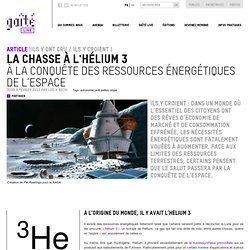
Dès 2006, elle avait divulgué des ambitions très réfléchies et planifiées dans le temps. Après avoir exposé un plan extrêmement précis quant aux besoins énergétiques de l'Empire du Milieu, Ouyang Ziyuan, le scientifique en chef du programme lunaire chinois clamait à l'époque que « le premier à conquérir la Lune sera le premier à en bénéficier ». Selon les objectifs avancés, les Chinois envisageraient de pouvoir établir une base lunaire en 2024 et de commencer à raffiner l'hélium 3 dès l'année suivante, si tant est que la technologie pour le faire soit mise au point d'ici là. Mais arrivé à ce stade, c'est à se demander si la Lune ne serait pas qu'une étape dans une dynamique humaine consistant à pourvoir à ses nécessités énergétiques en exploitant les ressources des astres voisins.
The Asteroid Mining Company – Opportunities. The Economist - Asteroid mining - Fool's platinum? INFOGRAPHIC: Why asteroid mining can create a trillion-dollar industry. Space mining start-up Planetary Resources has put together quite the infographic to explain how asteroid mining will create a trillion-dollar industry.
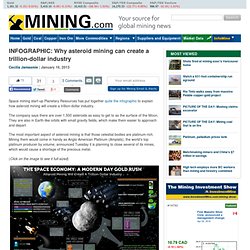
The company says there are over 1,500 asteroids as easy to get to as the surface of the Moon. They are also in Earth-like orbits with small gravity fields, which make them easier to approach and depart. The most important aspect of asteroid mining is that those celestial bodies are platinum-rich. Mining them would come in handy as Anglo American Platinum (Amplats), the world’s top platinum producer by volume, announced Tuesday it is planning to close several of its mines, which would cause a shortage of the precious metal. (Click on the image to see it full-sized) Amplats shuts mines, axes 14,000 jobs and sends platinum prices skyrocketing>> >> Asteroid Mining Mission Revealed by Planetary Resources, Inc. Planetary Resources – The Asteroid Mining Company. NASA takes asteroid mining seriously; funds viability study.
Only five months after Google’s billionaire co-founders and filmmaker James Cameron officially launched their asteroid mining focused Planetary Resources company, the U.S.
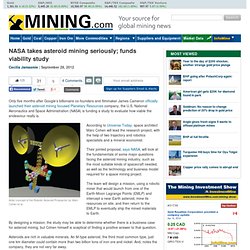
National Aeronautics and Space Administration (NASA) is funding a study to evaluate how viable the endeavour really is. According to Universe Today, space architect Marc Cohen will lead the research project, with the help of two trajectory and robotics specialists and a mineral economist. Their jointed proposal, says NASA, will look at the fundamentals of some major questions facing the asteroid mining industry, such as the most suitable kinds of spacecraft needed, as well as the technology and business model required for a space mining project. The team will design a mission, using a robotic miner that would launch from one of the Earth-Moon Lagrange Points (EMLP) and intercept a near Earth asteroid, mine its resources on site, and then return to the EMLP to eventually ship the mined materials to Earth.
Want to intern for an asteroid mining startup? Maybe you thought the James Cameron-backed startup Planetary Resources wasn't serious when they announced their intention to mine asteroids and bring the precious resources back to Earth.
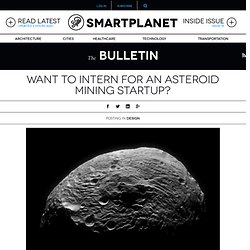
But it was no joke. The company recently announced what could be the coolest (paid!) Internship ever (as long as it doesn't turn out like this). Dawn Sees Hydrated Minerals on Giant Asteroid. NASA’s Dawn spacecraft has revealed that the giant asteroid Vesta has its own version of ring around the collar.
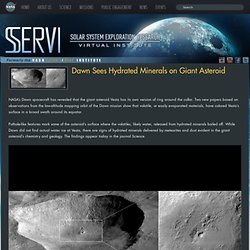
Two new papers based on observations from the low-altitude mapping orbit of the Dawn mission show that volatile, or easily evaporated materials, have colored Vesta’s surface in a broad swath around its equator. Pothole-like features mark some of the asteroid’s surface where the volatiles, likely water, released from hydrated minerals boiled off. While Dawn did not find actual water ice at Vesta, there are signs of hydrated minerals delivered by meteorites and dust evident in the giant asteroid’s chemistry and geology.
The findings appear today in the journal Science. One paper, led by Thomas Prettyman, the lead scientist for Dawn’s gamma ray and neutron detector (GRaND) at the Planetary Science Institute in Tucson, Ariz., describes how the instrument found signatures of hydrogen, likely in the form of hydroxyl or water bound to minerals in Vesta’s surface. Asteroid-mining firm hiring “space nuts” and interns. Google’s billionaire co-founders and filmmaker James Cameron’s owned asteroid-mining focused Planetary Resources has started hiring interns for 2013.

The much-hyped start-up is seeking college students for paid positions starting in January to help develop the next-generation technology for space mining. Planetary Resources’ president Chris Lewicki, who bills himself as “chief asteroid miner," says the company hopes to launch the first mining mission by the end of the decade. If you think you are a bit too old for an internship, there are also other job listings at Planetary Resources, including one posting calling for a "General Space Nut. " The company says to prepare among others for the following questions during the job interview: Planetary Resources Help-Wanted Messages Signal the New Commercial Space Age.
Billionaires and Futurists Plan Space Missions to Mine Asteroids for Metals. It’s been long thought, especially in science-fiction, that once Earth’s dwindling metallic resources dry up, the human race would look to the stars for precious metals.
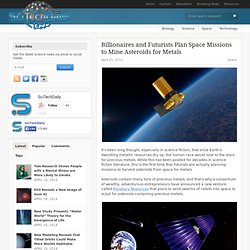
While this has been posited for decades in science-fiction literature, this is the first time that futurists are actually planning missions to harvest asteroids from space for metals. Asteroids contain many tons of precious metals, and that’s why a consortium of wealthy, adventurous entrepreneurs have announced a new venture called Planetary Resources that plans to send swarms of robots into space to scout for asteroids containing precious metals. They state that there are plenty of riches available in the solar system, making the ones on Earth pale in comparison. There are nearly 9,000 asteroids larger than 150 feet in diameter near Earth’s orbit. ZUBRIN: Tapping resources in space. Entrepreneur Peter Diamandis recently announced the formation of Planetary Resources, a company whose goal is to mine asteroids for profit.

While reportedly backed by a group of Google magnates and other high rollers, the prospects for this company appear quite problematic, as there is currently no technically feasible way to mine the precious metals that may exist in the asteroid belt and return them to Earth for sale. Yet, this picture could be changed radically were a law enacted that would create a basis for private-property claims in space. The asteroids, the Moon, Mars and other extraterrestrial bodies collectively contain vast areas of unexplored and potentially resource-rich territory.
They carry no commercial value today, but this can be remedied swiftly. Thus, if a mechanism were put in place that could enforce private-property rights in space, mining claims probably could be bought and sold now. Lawmakers should take note and act accordingly.